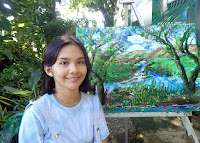Kapre - Monster or Spirit?
Dr Abe V Rotor
The kapre is perhaps the most popular Philippine mythological character. Grownups and children regard the kapre either as monster or spirit. As monster it is bad and feared; as spirit it is kind and respected.

Old folks tell us the kapre assumes a dual role, and therefore, lives in parallel worlds, like us. And when their worlds meet with ours, different scenarios capture our senses and imagination.
Scenarios of such encounters have been passed on through generations and many survive to this day.
They occupy a respectable place in Philippine literature, but versions in comics, movies and animations are creating different images of this mythological huge, black and hairy, creature.
Here is a personal encounter with the kapre.
“Did you hear that?” I was startled by a mysterious moaning in the dark. I switched on the headlight.
“What is it?” Cecille sleepily responded.
“It’s a strange sound, like someone agonizing.” I said while straining my eyes on the sugarcane fields on both sides of the road.
We had just parked along a newly opened road of the North Diversion somewhere in Tarlac that night. My wife and I were driving to Manila after a vacation in our hometown in Ilocos. I was so tired driving; I pulled our Ford Escort to the grass lane for a brief rest, and switched off the engine.
Then. “Did you hear that?” Cecille shook me. It was the same agonizing sound I heard earlier, and it was getting louder!
I switched on the headlight, and there stood at the opposite side of the road a tall figure the outline of the Colossus of Rhodes – black and hairy, so huge I could barely see his torso.
Instinctively I started the engine and stepped on the gas. Cecille moved close to me as the monster took another step toward us. We escaped in the nick of time.
Since then I became popular with children. “Tell us about the kapre!” And they would gather around clinging to one another. It reminded me of Lola Basiang, the story teller of folklores and legends.
My story became known to my friends and officemates. It was the cause of a meeting suddenly losing its agenda to the kapre. Everyone had something to say about the mythical monster. They talked about kapre living atop big old trees, along rivers and lakes. One related his experience while clearing the vines clinging around a large tree when suddenly he noticed blood dripping from above.
He looked up. Kapre!
Old folks say there are different kinds of kapre. There is even one taking over abandoned houses and empty buildings. There is kapre on empty playgrounds, farms and pastures. Kapre in gambling places, like the cockpit, kapre appearing suddenly in a group picture.
Since then we didn’t have to stay in office late. We had to finish our work early so we would not be taking the stairway that is seldom used, or hear typewriters clicking when everyone had already left. We won’t be passing dark alleys on our way home.
Children who heard the story of the kapre would stop playing at dusk. The farmer looks at the leaves of acacia, and when they start drooping, starts walking for home. Everyone in the family must be home for supper.
Because of the kapre, trees are spared of the ruthless chain saw. People passing through thickets politely whisper, “tabi tabi, po.” Fishermen catch just enough fish for their family’s need. Harvest festivals are observed even if harvest is not good.
Indeed there are different kinds of kapre. And they abound everywhere.
When I was buying a new battery for my car and told the salesman how I encountered a kapre one dark night, he handed me a new brand of battery.
“Sir, makakasiguro kayo dito.” (Sir, you are very safe with this battery.) ~
Playing with the Kapre
He is a friend, he is an enemy;
the world is divided in two;
but who is friend, who is enemy,
when you talk about kapre?
He can be seen, to others unseen,
appears to one, not to another;
at daytime or in the evening;
it's his choice. Oh, brother!
He is kind, although scary;
seldom loved and feared by most,
lonely and misunderstood;
unlike any other ghost;
He watches children passing by
prods them home before dark;
warns them not to tarry where
danger lurks, where dogs bark.
He watches fruits until they're ripe
and shoos away trespassers,
makes loggers sick from guilt,
keeps the menagerie from hunters
He sways in the trees and comes down
awhile to the young in company;
teaching them in discreet allegory
a unique children's story.
Can you describe the kapre, his looks, habits and places he frequents? What is the counterpart of the kapre in other countries? Where does he live? Is he diurnal or nocturnal? Or crepuscular (active during dusk)? Is there reason for the kapre to exist? In the first place, does he (It is believed to be male) really exist? What is his mission, if any?


























.JPG)
.JPG)
.JPG)

.JPG)
.JPG)










